七下 期末复习课件Unit 7-Unit 9 考点复习课件(共46张PPT)
文档属性
| 名称 | 七下 期末复习课件Unit 7-Unit 9 考点复习课件(共46张PPT) | 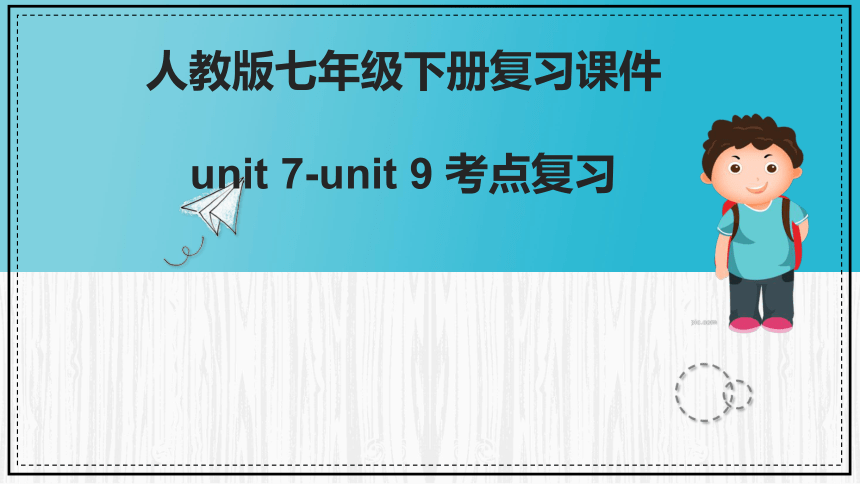 | |
| 格式 | pptx | ||
| 文件大小 | 2.1MB | ||
| 资源类型 | 教案 | ||
| 版本资源 | 人教新目标(Go for it)版 | ||
| 科目 | 英语 | ||
| 更新时间 | 2024-06-25 13:31:50 | ||
图片预览

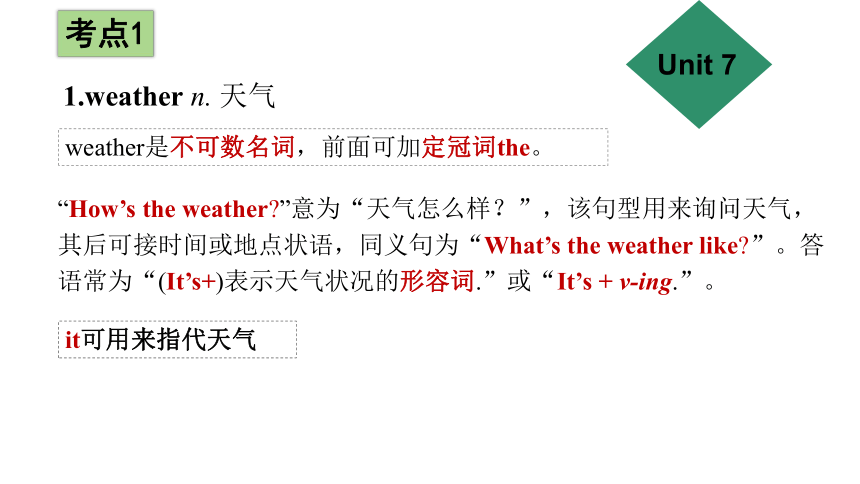



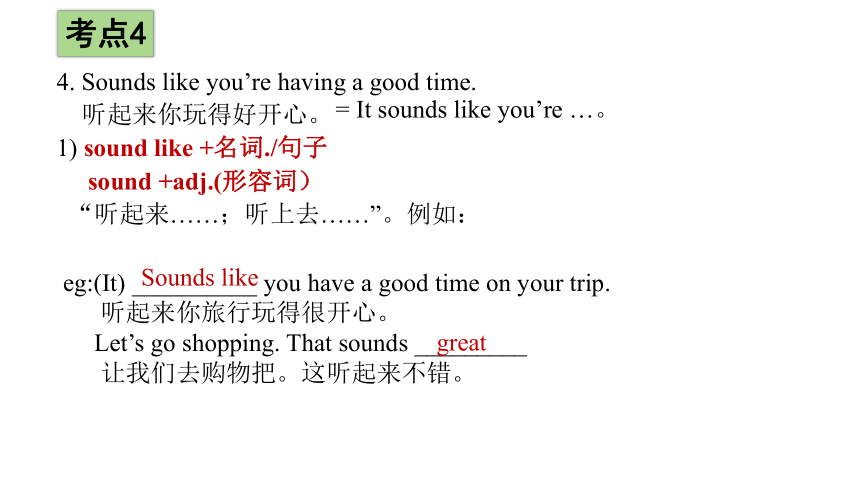
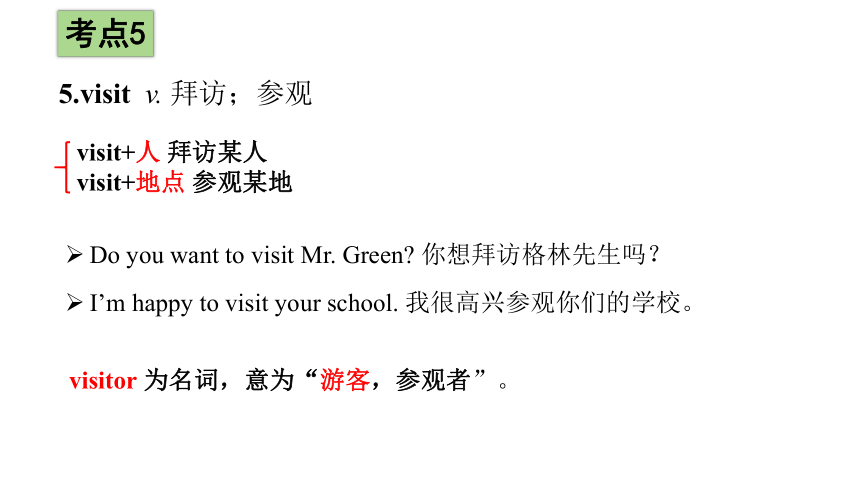
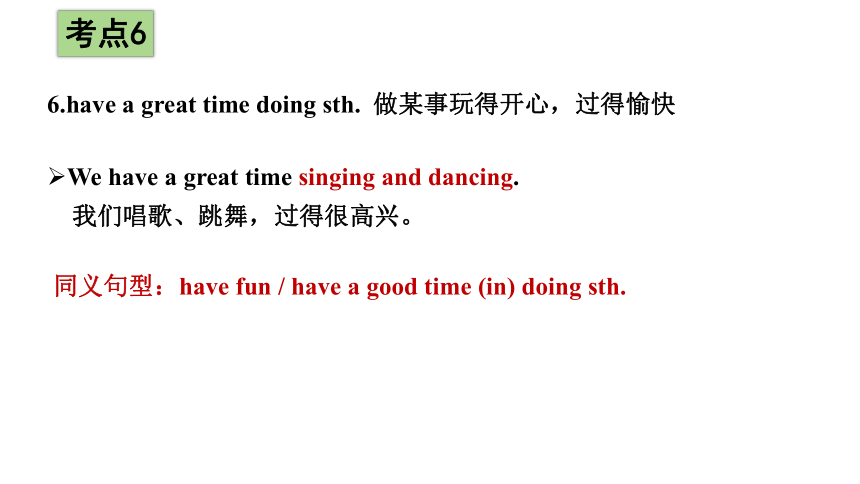
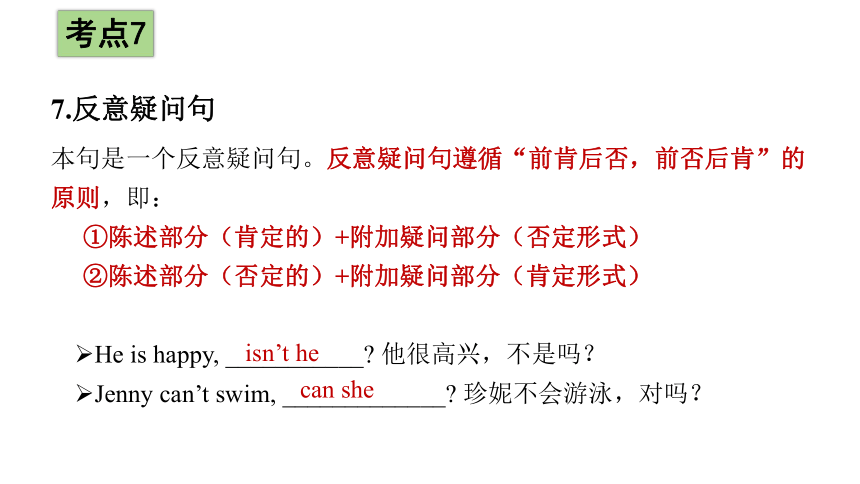
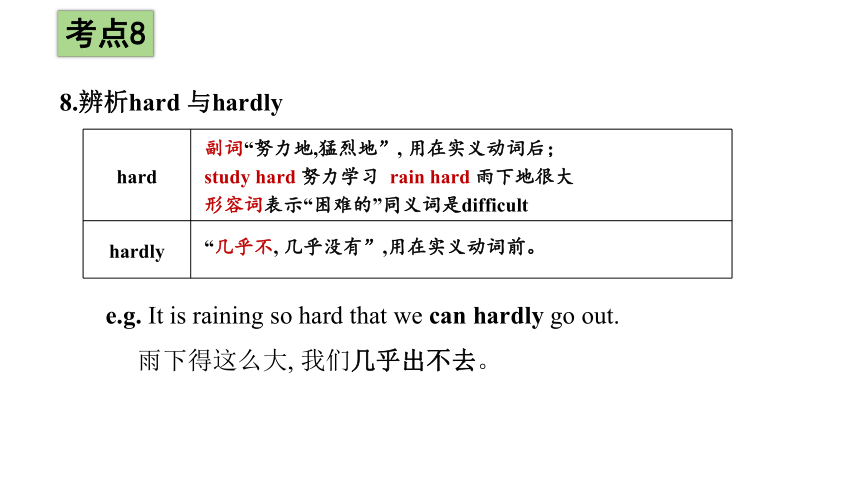
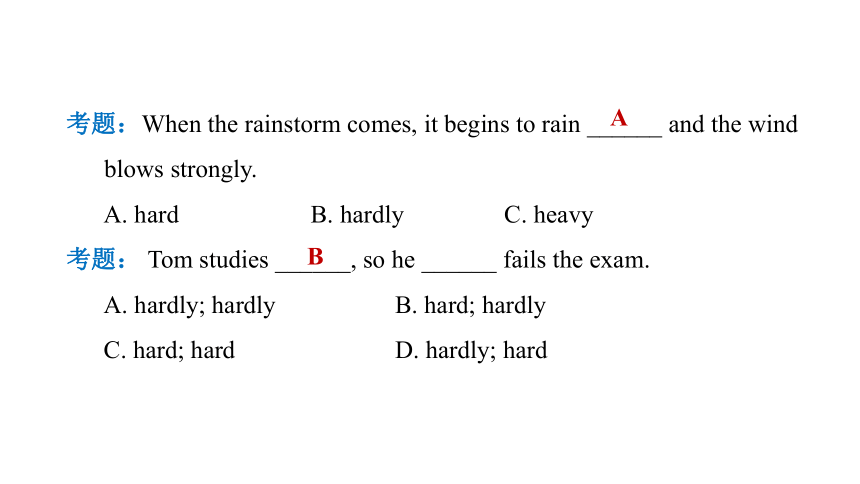
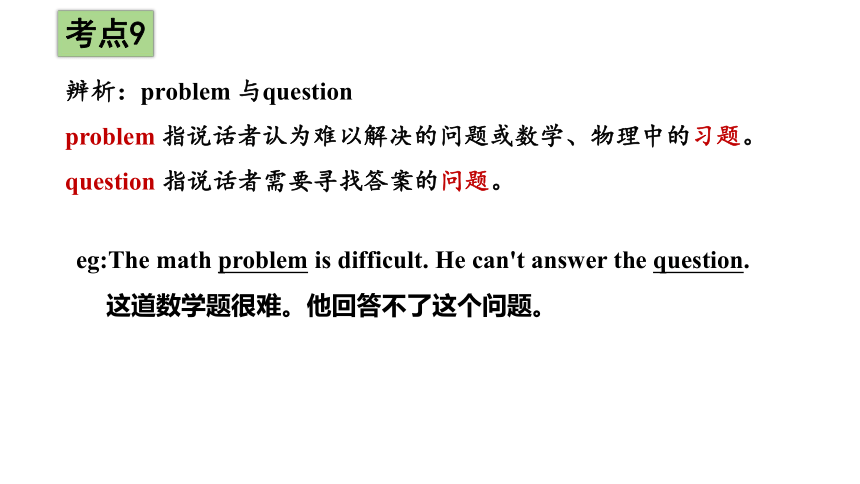
文档简介
(共46张PPT)
人教版七年级下册复习课件
unit 7-unit 9 考点复习
考点1
1.weather n. 天气
“How’s the weather ”意为“天气怎么样?”,该句型用来询问天气,其后可接时间或地点状语,同义句为“What’s the weather like ”。答语常为“(It’s+)表示天气状况的形容词.”或“It’s + v-ing.”。
weather是不可数名词,前面可加定冠词the。
it可用来指代天气
Unit 7
2.rain/re n/ v. 下雨 n. 雨水
考点2
rain hard/heavily 雨下得很大
Exercise: —What’s the weather like today
—It’s a _______ day. It’s _______ heavily now.
A. raining; rainy B. rainy; raining
C. rainy; rainy D. raining; raining
B
考点3
3. — How’s it going 近来可好?
— Not bad, thanks. 不错,谢谢。
这是英语中进行问候时的用语, 用于询问对方的近况或事情进展的情况,可译作“最近怎么样?”“一切还好吗?”。其后可接介词短语with sb. / sth., 其答语通常为:“Fine! / Pretty good! / Not bad! / Just so-so. ”等 。
—How’s it going with your English 你的英语学习情况怎么样?
—Pretty good. 非常好。
考点4
4. Sounds like you’re having a good time.
听起来你玩得好开心。
1) sound like +名词./句子
sound +adj.(形容词)
“听起来……;听上去……”。例如:
eg:(It) __________ you have a good time on your trip.
听起来你旅行玩得很开心。
Let’s go shopping. That sounds _________
让我们去购物把。这听起来不错。
Sounds like
great
= It sounds like you’re …。
考点5
visit+人 拜访某人
visit+地点 参观某地
5.visit v. 拜访;参观
Do you want to visit Mr. Green 你想拜访格林先生吗?
I’m happy to visit your school. 我很高兴参观你们的学校。
visitor 为名词,意为“游客,参观者”。
考点6
6.have a great time doing sth. 做某事玩得开心,过得愉快
We have a great time singing and dancing.
我们唱歌、跳舞,过得很高兴。
同义句型:have fun / have a good time (in) doing sth.
考点7
7.反意疑问句
本句是一个反意疑问句。反意疑问句遵循“前肯后否,前否后肯”的原则,即:
陈述部分(肯定的)+附加疑问部分(否定形式)
陈述部分(否定的)+附加疑问部分(肯定形式)
He is happy, ___________ 他很高兴,不是吗?
Jenny can’t swim, _____________ 珍妮不会游泳,对吗?
isn’t he
can she
考点8
8.辨析hard 与hardly
hard
hardly
e.g. It is raining so hard that we can hardly go out.
雨下得这么大, 我们几乎出不去。
副词“努力地,猛烈地”, 用在实义动词后;
study hard 努力学习 rain hard 雨下地很大
形容词表示“困难的”同义词是difficult
“几乎不, 几乎没有”,用在实义动词前。
考题:When the rainstorm comes, it begins to rain ______ and the wind blows strongly.
A. hard B. hardly C. heavy
考题: Tom studies ______, so he ______ fails the exam.
A. hardly; hardly B. hard; hardly
C. hard; hard D. hardly; hard
A
B
辨析:problem 与question
problem 指说话者认为难以解决的问题或数学、物理中的习题。question 指说话者需要寻找答案的问题。
考点9
eg:The math problem is difficult. He can't answer the question.
这道数学题很难。他回答不了这个问题。
考点1
There be 句型
一、构成: There be+某物/某人+某地
某地有某物/某人
我的铅笔盒里有两块橡皮。
_____ ___ two erasers in my pencil box.
房子前有一棵大树。
_____ __ a tall tree in front of the house.
There is
There are
Unit 8
_______ ____ a ruler and two erasers in my box.
_______ ____ two erasers and a ruler in my box.
注意:
There are
结论:(1)
There is
There be句型中的主谓一致, 即就近原则
E. g. ____ ____ a book on the desk.
____ ____ some water in the cup.
There is
There is
E.g.______ _____ many trees in the park.
There are
结论:(2)
句子主语是单数可数名词或不可数名词, be动词用“is”。
句子主语是复数名词,be动词用“are”。
桌子上有一架模型飞机。
_____ ____ a model plane on the desk.
我有一架模型飞机。
I _____ a model plane.
桌子有四条腿
A desk _____ four legs.
have
There is
结论: there be 在某处有某物,即“存在有”
have/has 某人或某物+有+某物,
即“ (某物属于某人或某物)属于有”
has
there be 与 have/ has的区别
时态的变化(了解)
一般现在时:
There is a library over there.
There are five trees here.
一般过去时:
There was a library over there.
There were five trees here
一般将来时:
There will be a new book store here.
There are going to be new houses here.
下面时态,先了解:
考点2
on
under
in
B:It’s … the box.
behind
near
next to
in front of
across from
between…and…
A:Where is the soccer ball
地点介词
考点3
“在……对面”
3. across from
across :介词, “从一边到另一边;横过”。 在物体表面上横穿,如过河桥马路等。动词+ across=cross(动词)
类比:through 指的是从内部穿过,比如窗户,隧道等。常构成短语go/walk through
Eg:过马路:
cross the street = go/walk across the street
Eg:穿过窗户:
go/walk through the window
1. We must _____the road carefully.
2. When you go _________ the road, you should look left first and then right.
3. A bird flies___________the window.
cross
across
through
选词填空:cross, across,through:
考点4
辨析: in front of 与in the front of
in front of 强调一个物体在另一个物体外部的前面 The dog is in front of the bus.那只狗在公共汽车的前面。
in the front of 强调一个物体在另一 个物体内部的前面 The driver is in the front of the bus.
司机在公共汽车的前部。
考点5
辨析: in hospital 与in the hospital
in hospital 指“生病住院”, hospital 是一个抽象名词。
in the hospital 指“在医院”, 可能是到医院工作, 可能是看护病人。由于有了定冠词the的限制, hospital成了一个具体指某个地点的名词。
考点6
far from 远离
e.g. My home is not far(away) from our school.
我的家离我们学校不远。
The station is two kilometers(away) from here.
车站离这儿有两千米远。
不与具体数字连用,牢记!
far from 相当于far away from, 通常不与具体数字连用,若出现具体数字,常用away from。
考点7
【易混辨析】spend, cost, pay与take
常用结构构
spend
cost
pay
take
事/物 +cost(s)+
+
+ pays+
+for + 物
It takes+
+时间 + to do sth.
1.I have a lot of work to do today, it ___me too much time.
A. takes B. costs C. spends D. use
2. Don’t____ too much time on that computer game.
A. cost B. take C. use D. spend
3.Don’t spend too much money ____ coffee.
A. drink B. drinks C. drank D. drinking
Exercise
A
D
D
考点8
watch sb./sth. doing sth. 看某人/某物在做某事
watch sb./sth. doing sth. I watched Gina playing the piano.我看吉娜在弹钢琴。
watch sb./sth. do sth. I often watch Gina play the piano.
我经常看吉娜弹钢琴。
意为“看某人/某物在做某事”,强调看到动作正在进行。
意为“观看某人/某物做某事”,强调看到动作经常发生或看到动作发生的全过程。
考点9
enjoy/ nd / v. 享受;喜爱
e.g. Sue enjoys listening to music in her free time.
休在闲暇时喜欢听音乐。
—We are going to the beach! 我们要去海滩了!
—Enjoy yourselves !玩得开心!
enjoy 后跟名词、代词或动词的-ing 形式。
反身代词,在人称和数上与enjoy的主语保持一致。
考点1
学会询问长相
句型: What+do/does+sb. + look like
e.g. What do you look like 你长什么样
What does he look like 他长什么样
Unit 9
考点2
学会描述长相
①主语+ be 动词+ 形容词.
②主语+ be+of + 形容词+ 名词.
③主语+ has/have +(a/an +) 形容词+ 名词.
④主语+ wear(s)+ 名词. → 描述戴眼镜及所穿衣服
考点3
形容词是用来描述、修饰名词或代词的词, 表示人或物的性质、特征和状态,如事物的颜色、大小、形状、长短、新旧等,人的高矮胖瘦、五官、发型等。
描述性形容词
形容词的用法
形容词通常在句中作定语、表语和宾语补足语等。
e.g. She is a beautiful girl. 她是一个漂亮的姑娘。(定语)
The game is quite interesting.
这个游戏相当有趣。(表语)
We must keep the classroom clean.
我们必须保持教室清洁。(宾语补足语)
考点3
多个描述性形容词摆放口诀:县官行令谢国才
口诀 说明 示例
县(限) 限定词,包括冠词,指示代词,形容词性物主代词,名词所有格,数词等 the, this, that, my, Tom's, two
官(观) 表示观点的描述性形容词 fine, beautiful, interesting
行(形) 表示大小,长短,高低及形状的形容词 small, long, tall, round
令(龄) 表示年龄,新旧的形容词 young, old, new
谢(色) 表示颜色的形容词 red, black, white
国 表示国籍,地区,出处的形容词 English,American
才(材) 表示中心名词构成材料的形容词 wooden, stone, plastic
考点3
考题2.-The man with _______ hair is a musician.
A. long curly brown B. long brown curly
C. curly long brown D. brown long curly
考题1.They have got a _________ table.
A. round wooden brown B. round brown wooden C. brown round wooden D. brown wooden round
考点4
一般疑问句和选择疑问句
一般疑问句用yes或no来回答;选择疑问句的两个选择项则用or连接,回答时不能用yes或no回答,而是根据实际情况选择符合事实的陈述句。
eg:Does your English teacher have straight hair or curly hair
She has curly hair.
考题: —Which sport do you prefer, volleyball ______ basketball
—I prefer volleyball.
A. or B. and C. but
考题: —Do you often go to Jingyue Park by car or by bike
—_______. I think it’s good for the environment and our health.
A. Yes, I do B. No, I don’t
C. By bike D. By car
A
C
考点5
【易混辨析】few/a few与 little/a little
few There are few eggs in the refrigerator. 冰箱里没几个鸡蛋了。
a few His mother works a few hours a day.他妈妈一天工作几个小时。
little I have little free time. 我几乎没有空闲时间。
a little I know a little French. 我懂一点儿法语。
修饰可数名词复数
修饰不可数名词
表示否定含义,“几乎没有”
表示肯定含义,“少量;一些”
表示否定含义,“几乎没有”
表示肯定含义,“一点;少量”
a little作状语,意为“一点”,可修饰形容词或副词,表示程度,与a bit、a little bit同义。
eg:It’s a little hot today. 今天有点儿热。
eg:The question is a little difficult. 这个问题有点难。
考点6
glasses/ɡlɑ s z/ n. 眼镜
e. g. This pair of glasses looks very nice.
这副眼镜看起来非常漂亮。
谓语用单数,和pair 保持一致
注意:a pair of glasses/this pair of glasses 作主语时, 谓语动词用单数。
拓展: glass 的其他用法
glass “玻璃”, 不可数名词。 I’d like some colourful glass.
我想要些彩色的玻璃。
“玻璃杯”, 可数名词, 复数形式是glasses。 There are two glasses of coffee for them.
有两杯给他们的咖啡。
考点7
may be 结构为: 情态动词+be动词。在句中作谓语, 置于主语后面。 I may be able to help you.
我也许可以帮助你。
maybe 作副词, 意为“或许, 也许, 可能”。在句中作状语。 Maybe you could move the chair. 也许你可以挪动一下那把椅子。
辨析: may be 与maybe
速记小法:巧记maybe 与may be 合首分中
考点8
辨析: person 与people
person 意为“人”, 着重指个人。作可数名词, 常指有个性的、特定的人。 There are three persons in their team. 他们队有三个人。
people 意为“人们”, 着重指全体, 作集合名词, 表复数概念。 There are many people at the party. 聚会上有许多人。
考点9
辨析:each 与every
each 常指两者或两者以上中的每一个,侧重整体中的个体。既可作形容词,又可作代词(可单独使用,也可与of连用)。 Every/Each student is in the classroom and each does his homework. 所有学生都在教室里,各自做着自己的作业。
every 指三者或三者以上中的每一个,侧重整体。every是限定词,只能作定语,不可单独使用,也不可与of连用。 考点10
辨析: other, others, the other, the others与another
other 其余的(人或物) , 后接复数名词。 I can see some other boys.
我可以看到一些其他的男孩。
others 除一部分以外剩余的另一些(并非全部) , 相当于“other+复数名词”。 A lot of people are in the park.
Some are singing, some are
dancing, and others are running.
许多人在公园里, 一些在唱歌, 一些在跳舞, 另一些在跑步。
the other 两个之中的另一个。 one. . . the other. . . 一个……另一个…… One cat is black and white, and the other is yellow. 一只猫是黑白相间的, 另一只是黄色的。
the others 指一定范围内“剩余的全部的人或物”, 相当于“the other +复数名词” There are 20 students. 15 of them are boys, and the others are girls. 有20名学生, 15名是男孩, 其余的是女孩。
another 指三者或三者以上的“再一个/ 又一个/另一个(人或事物) ”; 作形容词时, 只修饰可数名词单数。 I want to have another apple.
我想再吃一个苹果。
考题: Some people are too shy to say a word in public.
However, _______ aren’t.
A. another B. the other
C. others D. the others
【解析】用语法分析法解题。句意为“一些人在公共场所太害羞了而不能说话。然而, 另一些人不这样”。“一些……, 另一些(并非全部) ……”, 应用“some . . . others. . . ”。
C
in the end 最后; 终于
e.g. He studied hard and he passed the exam in the end.
他努力学习,最后通过了考试。
in the end=at last/finally,in the end 的反义短语是at first“起初”
考点11
拓展:at the end of +时间/地点
e.g. They’ll come at the end of March.
他们将在3 月底到来。
We walked to the end of the road.
我们走到了路的尽头。
考题:The man tried several times (尝试了几次) to start the car, and he succeeded(成功) _______.
A. in the past B. in the end C. at first D. at once
时间
地点
B
人教版七年级下册复习课件
unit 7-unit 9 考点复习
考点1
1.weather n. 天气
“How’s the weather ”意为“天气怎么样?”,该句型用来询问天气,其后可接时间或地点状语,同义句为“What’s the weather like ”。答语常为“(It’s+)表示天气状况的形容词.”或“It’s + v-ing.”。
weather是不可数名词,前面可加定冠词the。
it可用来指代天气
Unit 7
2.rain/re n/ v. 下雨 n. 雨水
考点2
rain hard/heavily 雨下得很大
Exercise: —What’s the weather like today
—It’s a _______ day. It’s _______ heavily now.
A. raining; rainy B. rainy; raining
C. rainy; rainy D. raining; raining
B
考点3
3. — How’s it going 近来可好?
— Not bad, thanks. 不错,谢谢。
这是英语中进行问候时的用语, 用于询问对方的近况或事情进展的情况,可译作“最近怎么样?”“一切还好吗?”。其后可接介词短语with sb. / sth., 其答语通常为:“Fine! / Pretty good! / Not bad! / Just so-so. ”等 。
—How’s it going with your English 你的英语学习情况怎么样?
—Pretty good. 非常好。
考点4
4. Sounds like you’re having a good time.
听起来你玩得好开心。
1) sound like +名词./句子
sound +adj.(形容词)
“听起来……;听上去……”。例如:
eg:(It) __________ you have a good time on your trip.
听起来你旅行玩得很开心。
Let’s go shopping. That sounds _________
让我们去购物把。这听起来不错。
Sounds like
great
= It sounds like you’re …。
考点5
visit+人 拜访某人
visit+地点 参观某地
5.visit v. 拜访;参观
Do you want to visit Mr. Green 你想拜访格林先生吗?
I’m happy to visit your school. 我很高兴参观你们的学校。
visitor 为名词,意为“游客,参观者”。
考点6
6.have a great time doing sth. 做某事玩得开心,过得愉快
We have a great time singing and dancing.
我们唱歌、跳舞,过得很高兴。
同义句型:have fun / have a good time (in) doing sth.
考点7
7.反意疑问句
本句是一个反意疑问句。反意疑问句遵循“前肯后否,前否后肯”的原则,即:
陈述部分(肯定的)+附加疑问部分(否定形式)
陈述部分(否定的)+附加疑问部分(肯定形式)
He is happy, ___________ 他很高兴,不是吗?
Jenny can’t swim, _____________ 珍妮不会游泳,对吗?
isn’t he
can she
考点8
8.辨析hard 与hardly
hard
hardly
e.g. It is raining so hard that we can hardly go out.
雨下得这么大, 我们几乎出不去。
副词“努力地,猛烈地”, 用在实义动词后;
study hard 努力学习 rain hard 雨下地很大
形容词表示“困难的”同义词是difficult
“几乎不, 几乎没有”,用在实义动词前。
考题:When the rainstorm comes, it begins to rain ______ and the wind blows strongly.
A. hard B. hardly C. heavy
考题: Tom studies ______, so he ______ fails the exam.
A. hardly; hardly B. hard; hardly
C. hard; hard D. hardly; hard
A
B
辨析:problem 与question
problem 指说话者认为难以解决的问题或数学、物理中的习题。question 指说话者需要寻找答案的问题。
考点9
eg:The math problem is difficult. He can't answer the question.
这道数学题很难。他回答不了这个问题。
考点1
There be 句型
一、构成: There be+某物/某人+某地
某地有某物/某人
我的铅笔盒里有两块橡皮。
_____ ___ two erasers in my pencil box.
房子前有一棵大树。
_____ __ a tall tree in front of the house.
There is
There are
Unit 8
_______ ____ a ruler and two erasers in my box.
_______ ____ two erasers and a ruler in my box.
注意:
There are
结论:(1)
There is
There be句型中的主谓一致, 即就近原则
E. g. ____ ____ a book on the desk.
____ ____ some water in the cup.
There is
There is
E.g.______ _____ many trees in the park.
There are
结论:(2)
句子主语是单数可数名词或不可数名词, be动词用“is”。
句子主语是复数名词,be动词用“are”。
桌子上有一架模型飞机。
_____ ____ a model plane on the desk.
我有一架模型飞机。
I _____ a model plane.
桌子有四条腿
A desk _____ four legs.
have
There is
结论: there be 在某处有某物,即“存在有”
have/has 某人或某物+有+某物,
即“ (某物属于某人或某物)属于有”
has
there be 与 have/ has的区别
时态的变化(了解)
一般现在时:
There is a library over there.
There are five trees here.
一般过去时:
There was a library over there.
There were five trees here
一般将来时:
There will be a new book store here.
There are going to be new houses here.
下面时态,先了解:
考点2
on
under
in
B:It’s … the box.
behind
near
next to
in front of
across from
between…and…
A:Where is the soccer ball
地点介词
考点3
“在……对面”
3. across from
across :介词, “从一边到另一边;横过”。 在物体表面上横穿,如过河桥马路等。动词+ across=cross(动词)
类比:through 指的是从内部穿过,比如窗户,隧道等。常构成短语go/walk through
Eg:过马路:
cross the street = go/walk across the street
Eg:穿过窗户:
go/walk through the window
1. We must _____the road carefully.
2. When you go _________ the road, you should look left first and then right.
3. A bird flies___________the window.
cross
across
through
选词填空:cross, across,through:
考点4
辨析: in front of 与in the front of
in front of 强调一个物体在另一个物体外部的前面 The dog is in front of the bus.那只狗在公共汽车的前面。
in the front of 强调一个物体在另一 个物体内部的前面 The driver is in the front of the bus.
司机在公共汽车的前部。
考点5
辨析: in hospital 与in the hospital
in hospital 指“生病住院”, hospital 是一个抽象名词。
in the hospital 指“在医院”, 可能是到医院工作, 可能是看护病人。由于有了定冠词the的限制, hospital成了一个具体指某个地点的名词。
考点6
far from 远离
e.g. My home is not far(away) from our school.
我的家离我们学校不远。
The station is two kilometers(away) from here.
车站离这儿有两千米远。
不与具体数字连用,牢记!
far from 相当于far away from, 通常不与具体数字连用,若出现具体数字,常用away from。
考点7
【易混辨析】spend, cost, pay与take
常用结构构
spend
cost
pay
take
事/物 +cost(s)+
+
+ pays+
+for + 物
It takes+
+时间 + to do sth.
1.I have a lot of work to do today, it ___me too much time.
A. takes B. costs C. spends D. use
2. Don’t____ too much time on that computer game.
A. cost B. take C. use D. spend
3.Don’t spend too much money ____ coffee.
A. drink B. drinks C. drank D. drinking
Exercise
A
D
D
考点8
watch sb./sth. doing sth. 看某人/某物在做某事
watch sb./sth. doing sth. I watched Gina playing the piano.我看吉娜在弹钢琴。
watch sb./sth. do sth. I often watch Gina play the piano.
我经常看吉娜弹钢琴。
意为“看某人/某物在做某事”,强调看到动作正在进行。
意为“观看某人/某物做某事”,强调看到动作经常发生或看到动作发生的全过程。
考点9
enjoy/ nd / v. 享受;喜爱
e.g. Sue enjoys listening to music in her free time.
休在闲暇时喜欢听音乐。
—We are going to the beach! 我们要去海滩了!
—Enjoy yourselves !玩得开心!
enjoy 后跟名词、代词或动词的-ing 形式。
反身代词,在人称和数上与enjoy的主语保持一致。
考点1
学会询问长相
句型: What+do/does+sb. + look like
e.g. What do you look like 你长什么样
What does he look like 他长什么样
Unit 9
考点2
学会描述长相
①主语+ be 动词+ 形容词.
②主语+ be+of + 形容词+ 名词.
③主语+ has/have +(a/an +) 形容词+ 名词.
④主语+ wear(s)+ 名词. → 描述戴眼镜及所穿衣服
考点3
形容词是用来描述、修饰名词或代词的词, 表示人或物的性质、特征和状态,如事物的颜色、大小、形状、长短、新旧等,人的高矮胖瘦、五官、发型等。
描述性形容词
形容词的用法
形容词通常在句中作定语、表语和宾语补足语等。
e.g. She is a beautiful girl. 她是一个漂亮的姑娘。(定语)
The game is quite interesting.
这个游戏相当有趣。(表语)
We must keep the classroom clean.
我们必须保持教室清洁。(宾语补足语)
考点3
多个描述性形容词摆放口诀:县官行令谢国才
口诀 说明 示例
县(限) 限定词,包括冠词,指示代词,形容词性物主代词,名词所有格,数词等 the, this, that, my, Tom's, two
官(观) 表示观点的描述性形容词 fine, beautiful, interesting
行(形) 表示大小,长短,高低及形状的形容词 small, long, tall, round
令(龄) 表示年龄,新旧的形容词 young, old, new
谢(色) 表示颜色的形容词 red, black, white
国 表示国籍,地区,出处的形容词 English,American
才(材) 表示中心名词构成材料的形容词 wooden, stone, plastic
考点3
考题2.-The man with _______ hair is a musician.
A. long curly brown B. long brown curly
C. curly long brown D. brown long curly
考题1.They have got a _________ table.
A. round wooden brown B. round brown wooden C. brown round wooden D. brown wooden round
考点4
一般疑问句和选择疑问句
一般疑问句用yes或no来回答;选择疑问句的两个选择项则用or连接,回答时不能用yes或no回答,而是根据实际情况选择符合事实的陈述句。
eg:Does your English teacher have straight hair or curly hair
She has curly hair.
考题: —Which sport do you prefer, volleyball ______ basketball
—I prefer volleyball.
A. or B. and C. but
考题: —Do you often go to Jingyue Park by car or by bike
—_______. I think it’s good for the environment and our health.
A. Yes, I do B. No, I don’t
C. By bike D. By car
A
C
考点5
【易混辨析】few/a few与 little/a little
few There are few eggs in the refrigerator. 冰箱里没几个鸡蛋了。
a few His mother works a few hours a day.他妈妈一天工作几个小时。
little I have little free time. 我几乎没有空闲时间。
a little I know a little French. 我懂一点儿法语。
修饰可数名词复数
修饰不可数名词
表示否定含义,“几乎没有”
表示肯定含义,“少量;一些”
表示否定含义,“几乎没有”
表示肯定含义,“一点;少量”
a little作状语,意为“一点”,可修饰形容词或副词,表示程度,与a bit、a little bit同义。
eg:It’s a little hot today. 今天有点儿热。
eg:The question is a little difficult. 这个问题有点难。
考点6
glasses/ɡlɑ s z/ n. 眼镜
e. g. This pair of glasses looks very nice.
这副眼镜看起来非常漂亮。
谓语用单数,和pair 保持一致
注意:a pair of glasses/this pair of glasses 作主语时, 谓语动词用单数。
拓展: glass 的其他用法
glass “玻璃”, 不可数名词。 I’d like some colourful glass.
我想要些彩色的玻璃。
“玻璃杯”, 可数名词, 复数形式是glasses。 There are two glasses of coffee for them.
有两杯给他们的咖啡。
考点7
may be 结构为: 情态动词+be动词。在句中作谓语, 置于主语后面。 I may be able to help you.
我也许可以帮助你。
maybe 作副词, 意为“或许, 也许, 可能”。在句中作状语。 Maybe you could move the chair. 也许你可以挪动一下那把椅子。
辨析: may be 与maybe
速记小法:巧记maybe 与may be 合首分中
考点8
辨析: person 与people
person 意为“人”, 着重指个人。作可数名词, 常指有个性的、特定的人。 There are three persons in their team. 他们队有三个人。
people 意为“人们”, 着重指全体, 作集合名词, 表复数概念。 There are many people at the party. 聚会上有许多人。
考点9
辨析:each 与every
each 常指两者或两者以上中的每一个,侧重整体中的个体。既可作形容词,又可作代词(可单独使用,也可与of连用)。 Every/Each student is in the classroom and each does his homework. 所有学生都在教室里,各自做着自己的作业。
every 指三者或三者以上中的每一个,侧重整体。every是限定词,只能作定语,不可单独使用,也不可与of连用。 考点10
辨析: other, others, the other, the others与another
other 其余的(人或物) , 后接复数名词。 I can see some other boys.
我可以看到一些其他的男孩。
others 除一部分以外剩余的另一些(并非全部) , 相当于“other+复数名词”。 A lot of people are in the park.
Some are singing, some are
dancing, and others are running.
许多人在公园里, 一些在唱歌, 一些在跳舞, 另一些在跑步。
the other 两个之中的另一个。 one. . . the other. . . 一个……另一个…… One cat is black and white, and the other is yellow. 一只猫是黑白相间的, 另一只是黄色的。
the others 指一定范围内“剩余的全部的人或物”, 相当于“the other +复数名词” There are 20 students. 15 of them are boys, and the others are girls. 有20名学生, 15名是男孩, 其余的是女孩。
another 指三者或三者以上的“再一个/ 又一个/另一个(人或事物) ”; 作形容词时, 只修饰可数名词单数。 I want to have another apple.
我想再吃一个苹果。
考题: Some people are too shy to say a word in public.
However, _______ aren’t.
A. another B. the other
C. others D. the others
【解析】用语法分析法解题。句意为“一些人在公共场所太害羞了而不能说话。然而, 另一些人不这样”。“一些……, 另一些(并非全部) ……”, 应用“some . . . others. . . ”。
C
in the end 最后; 终于
e.g. He studied hard and he passed the exam in the end.
他努力学习,最后通过了考试。
in the end=at last/finally,in the end 的反义短语是at first“起初”
考点11
拓展:at the end of +时间/地点
e.g. They’ll come at the end of March.
他们将在3 月底到来。
We walked to the end of the road.
我们走到了路的尽头。
考题:The man tried several times (尝试了几次) to start the car, and he succeeded(成功) _______.
A. in the past B. in the end C. at first D. at once
时间
地点
B
同课章节目录
